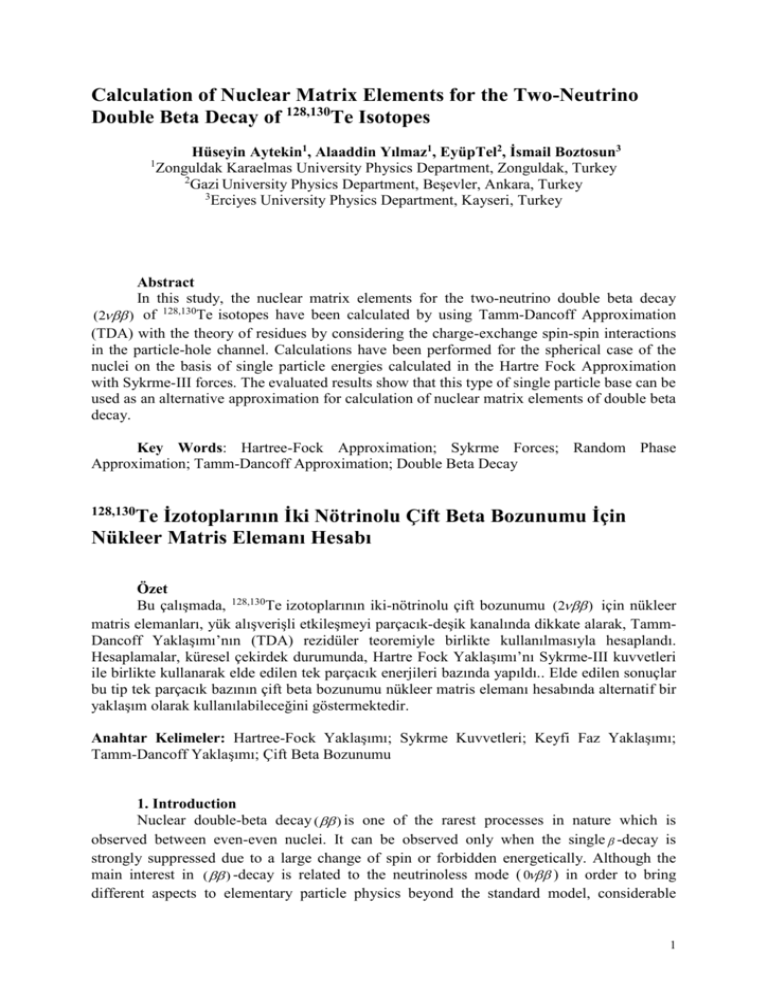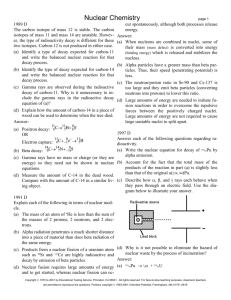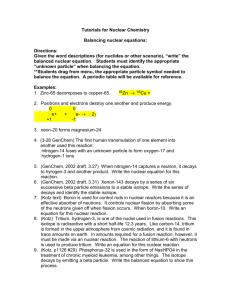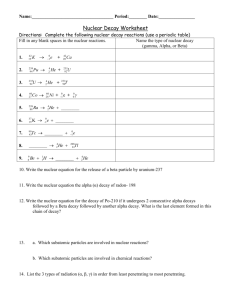NUCLEAR MATRİX ELEMENTS OF DOUBLE BETA DECAY
advertisement

Calculation of Nuclear Matrix Elements for the Two-Neutrino Double Beta Decay of 128,130Te Isotopes 1 Hüseyin Aytekin1, Alaaddin Yılmaz1, EyüpTel2, İsmail Boztosun3 Zonguldak Karaelmas University Physics Department, Zonguldak, Turkey 2 Gazi University Physics Department, Beşevler, Ankara, Turkey 3 Erciyes University Physics Department, Kayseri, Turkey Abstract In this study, the nuclear matrix elements for the two-neutrino double beta decay (2 ) of 128,130Te isotopes have been calculated by using Tamm-Dancoff Approximation (TDA) with the theory of residues by considering the charge-exchange spin-spin interactions in the particle-hole channel. Calculations have been performed for the spherical case of the nuclei on the basis of single particle energies calculated in the Hartre Fock Approximation with Sykrme-III forces. The evaluated results show that this type of single particle base can be used as an alternative approximation for calculation of nuclear matrix elements of double beta decay. Key Words: Hartree-Fock Approximation; Sykrme Forces; Random Phase Approximation; Tamm-Dancoff Approximation; Double Beta Decay Te İzotoplarının İki Nötrinolu Çift Beta Bozunumu İçin Nükleer Matris Elemanı Hesabı 128,130 Özet Bu çalışmada, 128,130Te izotoplarının iki-nötrinolu çift bozunumu (2 ) için nükleer matris elemanları, yük alışverişli etkileşmeyi parçacık-deşik kanalında dikkate alarak, TammDancoff Yaklaşımı’nın (TDA) rezidüler teoremiyle birlikte kullanılmasıyla hesaplandı. Hesaplamalar, küresel çekirdek durumunda, Hartre Fock Yaklaşımı’nı Sykrme-III kuvvetleri ile birlikte kullanarak elde edilen tek parçacık enerjileri bazında yapıldı.. Elde edilen sonuçlar bu tip tek parçacık bazının çift beta bozunumu nükleer matris elemanı hesabında alternatif bir yaklaşım olarak kullanılabileceğini göstermektedir. Anahtar Kelimeler: Hartree-Fock Yaklaşımı; Sykrme Kuvvetleri; Keyfi Faz Yaklaşımı; Tamm-Dancoff Yaklaşımı; Çift Beta Bozunumu 1. Introduction Nuclear double-beta decay ( ) is one of the rarest processes in nature which is observed between even-even nuclei. It can be observed only when the single -decay is strongly suppressed due to a large change of spin or forbidden energetically. Although the main interest in ( ) -decay is related to the neutrinoless mode ( 0 ) in order to bring different aspects to elementary particle physics beyond the standard model, considerable 1 efforts are made to investigate the ordinary allowed second order weak decay two neutrino mode ( 2 ) (Moe et al 1994, Suhonen et al 1998, Faessler et al 1998). Accumulation of experimental information for 2 processes (transitions to the ground and excited states), promotes a better understanding of nuclear part of -decay and allows one to check theoretical schemes of nuclear matrix element calculations for the two-neutrino mode. The reliable evaluation of the 2 -decay nuclear matrix elements is necessary to gain confidence for calculation of 0 –decay nuclear matrix element. Over the past few years, the nuclear matrix element has been calculated mainly in three types of models, namely Nuclear Shell Model (NSM) and its variants, the Quasiparticle Random Phase Approximation (QRPA) and its extensions and the alternative models. The details of these models have been discussed by Suhonen et al., (Suhonen et al., 1998) and Faessler et al., (Faessler et al 1998). NSM attempts to solve the nuclear many body problem as exactly as possible. Hence, it is the best choice for the calculation of the nuclear matrix elements. Despite of the advantages of calculation techniques only a limited set of single particle states can be used in NSM. QRPA is the nuclear much body method most widely used to deal with the nuclear structure aspects of the double beta decay process. The QRPA has been found successful in explaining the quenching of the 0 -decay nuclear matrix element and bring them into closer agreement with experimental values. But despite this success the QRPA approach to double beta decay has some shortcomings. The main problem is that results are extremely sensitivity to the renormalization of the attractive particle-particle component of residual interaction, which is large part responsible for suppressing calculated two-neutrino decay rate. Including proton-neutron pairing, several alternations have been made in QRPA. However, none of these alternations have changed the rapid variation of calculated 2 -decay matrix element with the increasing strength of the particle-particle interaction. Recently there have been made some corrections on quasi-boson approximation (Suhonen et al 1998) leading to a violation of the Pauli Exclusion Principle. Alternative models, as the operator expansion method (OEM), the broken SU (4) symmetry, two vacua RPA, the pseudo SU (3) and single state dominance hypothesis (SSDH) have their own problems (Suhonen et al., 1998). Recently, deformation structure in nuclei has been taken into account in calculation of nuclear matrix element (Selam, et al., 2003 and Chandra et al., 2005). In present, the calculated matrix elements are far away from the experimental results. In calculations of nuclear matrix elements, the wave functions and the energy eigenvalues of 1+ state in intermediate odd-odd nucleus should be considered. Since the 1+ state has a high density, in order to find the eigenvalues, it is necessary to solve complex equations. The problem can be solved analytically by using the theory of residues and counter integrals in Tamm-Dancoff Approximation (TDA) where the quasiparticle correlations are neglected in the ground state. Balaev et al. calculated nuclear matrix elements for selected nuclei in TDA using the theory of residues and counter integrals (Balaev et al., 1990). One should consider that the TDA is a rudimentary approximation because of neglecting quasiparticle correlations in ground states, but it brings simplicity to calculate nuclear matrix element, and reliability of any single particle energy basis can be tested. Bobyk and Kaminski showed that nuclear matrix element is strongly dependent on the choice of single particle energy basis (Bobyk et al., 1985). The single particle energies evaluated in the Hartree-Fock Approximation with Sykrme III Forces (HF+SIII) have not been used so far in calculation of double beta decay matrix element. Thus, in this work, it is aimed at testing the reliability of this single particle energy base for calculation of M 2 and 2 calculations have been done for 128,130Te isotopes by using the TDA with the theory of residues by considering the charge-exchange spin-spin interaction among nucleons in the particle-hole channel. In the next section, we give the theoretical description used in our analysis and then in section-3, we present our results and compare them with the experimental findings. Finally, section-4 is devoted to our conclusion. 2. Theory The half-life of 2 decay mode for 0 0 transition can be written in the form of (Haxton et al., 1984, Doi et al., 1985, Vergados et al., 1976) 2 2 , [T1 / 2 ]1 F 2 M GT (1) where F 2 is the exactly calculable phase space integral containing the entire relevant 2 constant, and M GT is the nuclear matrix element (there is no Fermi part, due to isospin conservation). This part is given by (Balaev et al., 1990) M 2 GT where A, Z 2 A, Z ( A, Z 2) n n ( A, Z ) n n W / 2 , (2) are the 0+ ground states of the final (initial) even-even nuclei, n are the 1+ state in the intermediate odd-odd nucleus of energy n and W is the 2 -decay energy, and are the Pauli spin operator and isospin operator successively? Table 1 show the W and F2 values for 128Te128Xe and 130Te130Xe transitions (Aliev, T.M., et al., 1989). Table 1 W and F2 Transitions Transitions 128 Te128Xe 130 Te130Xe values for Te128Xe and 128 W (MeV) 1.891 3.555 Te130Xe 130 F2ν (year-1MeV-1) 2.16x10-22 1.23x10-18 2.1. The Nuclear Model Consider a system of nucleus in spherical symmetric mean field interacting via pairing and effective charge-exchange spin-isospin interaction among the nucleons. Hamiltonian of the system can be written as H H av H pair V , (3) H av E j a jm a jm , (4) where jm H pair G a jm a j m a j m a jm , (5) H 0 H av H pair (6) jm V 1 i j i j . i j 2 (7) 3 Here, Eq. (4) represents single particle Hamiltonian with the energy of Ej, a jm (a jm ) are single particle creation and annihilation operators. The interaction, which causes pairing superfluid correlations, is represented by Hpair given by Eq. (5). Here, G is the pairing constant and takes different values for protons and neutrons. H0 describes the average motion of nucleons. Since the quasiparticle operator coincides with the particle (hole) operator for the states far above (below) the Fermi Level, one can express H0 using quasiparticle creation and annihilation operators as (Soloviev, V.G., 1976) H 0 H sqp jn jn mn jn mn j p j p m p j p m p . jm (8) jm Here ( ) are the quasiparticle creation (annihilation) operators with spin and parity 1+; these operators are defined as (9 a) a jm u j j m (1) j m v j jm , a jm u j j m (1) j m v j a jm . (9 b) Here, uj and vj coefficients are given by v 2j 1 Ej 2 2 1 ; ui 1 v j , 2 i (10) where j is the quasiparticle energy which is the eigenvalue of Hamiltonian Hsqp and given by (11) j 2 ( E j ) 2 , where denotes the energy gap parameter and is determined phenomenological from oddeven mass differences through a symmetric five terms formula involving the experimental binding energies (Möller, P. and Nix, J.R, 1992) 1 n [ B( N 2, Z ) 4 B( N 1, Z ) 6 B( N , Z ) 4 B( N 1, Z ) B( N 2, Z )]. 8 (12) A similar expression is found for proton gap p by changing N by Z and vice versa. Ej is the single particle energy of nucleons and is Fermi energy and can be calculated using the number equation, which is given by (Soloviev, V.G., 1976) Ej 1 N (1 )1 . 2 2 2 ( E ) j j (13) In Eq. (3), V is the charge-exchange Gamow-Teller interaction which is responsible for the -transitions in odd-odd nucleus in the particle-hole channel. Here, and Pauli spin operator and isospin operator. The part of V which generates the collective 1+ state in oddodd nuclei given as (Aytekin, H., and Kuliev, A.A., 1996) 4 coll V ph 2 TB TB (14) TB (bnpCnp ( ) (1) 1bnpCnp ( ) ; TB (TB ) (15) where np Cnp ( ) mn , m p bnp 1 3 3 J m (1) p p 2J n 1 u j p v jn J n J p J p m p1 J n mn j p m p j n mn , ; bnp 1 u j v j J n J p . 3 n (16) (17) p Here, Cnp (Cnp ) are the bosonic operators representing the creation (annihilation) of neutron proton pairs. Here, J n J p is reduced matrix element and given by (Suhonen et al., 1988) 11 j l 1 / 2 J n J p 6 p n l pln (1) p n W( j n j p ;1l n ) 22 (18) Where p and n denote all the other quantum numbers except the angular momentum quantum numbers. 2.2. QRPA and Collective 1+ States in Odd-Odd Nuclei In the QRPA, collective 1+ state is built of a linear combination of two-quasiparticle states. The wave function of this state is looked upon as one-phonon function and is given in the form (Aytekin, H. and Kuliev, A.A., 1996) n n n Qn 0 ( np C np ( ) (1) C np np ( )) 0 , (19) np where Q n is the phonon creation operator, 0 is the phonon vacuum which corresponds to n the ground states of parent even-even nucleus. The two quasiparticle amplitudes npn and np are normalized by np ( n 2 np ) n 2 ( np ) 1. (20) Following the conventional procedure of RPA and solving the equation motion H sqp coll V ph , Qn 0 n Qn 0 , (21) we obtain the dispersion relation for the excitation energy n of 1+ state in odd-odd nuclei as D1 ( n ) D2 ( n ) (2 ph D( n )) 2 0 , (22) where D ( ) , D1 ( n ), D2 ( n ) and D3 ( n ) functions are defined as D1 ( n ) 1 2 ph ( np 2 bnp np n bnp2 np n ), (23) 5 D2 ( n 1 2 ph ( np D3 ( n ) bnp bnp ( np bnp2 np n 2 bnp np n ), (24) 1 1 ), np n np n (25) D() D1 (n ) D2 (n ) (2 ph D3 (n )) 2 (26) where np n p is the two quasiparticle energy for neutron-proton pairs. Using the normalization form (20), we can easily obtain expressions for two n n quasiparticles amplitudes np and np : n np 1 Ynph ( bnp Ynph bnp np n n ), np 1 Ynph ( bnp Lnphbnp np n , (27) where 2 (bnp Ln bnp ) 2 (bnp Ln bnp ) , Yn 2 2 ( np n ) np ( np n ) 2 ph D3 ( n ) 1 2 pp D2 ( n ) . Ln 1 2 ph D1 ( n ) 2 pp D3 ( n ) (28) (29) If we discard factors containing 1 /( np i ) in (23)-(28), we obtain the formulas corresponding to the Tamm-Dancoff Approximation (TDA). 2.3. Nuclear Matrix Elements In this study, the ground states of the parent and daughter nuclei are assumed to be same, i.e. ( i f 0 ) . Matrix elements of beta transitions given in Eq. (2) take the form of M n f ( A, Z 2) 1n M n 1n i ( A, Z ) 1 2 ph Y (n ) L(n ) 2 ph Y (n ) , . (30) (31) 2 If we use (28) and (29), we find that the general expression for M GT , given in (2), in the form of 2 M GT 3 n M n M n n W / 2 . (32) Now the basic theorem of residues allows us to write the expressions for (32) (Balaev et al., 1990) in the following form: 2 M GT 3 D3 (W / 2) , D(W / 2) (33) Which is depended on the decay energy of W and the interaction constant ph . 3. Numerical Results and Discussions 6 The single-particle energies used in the numerical calculations were computed using the Hartree-Fock Approximation with Skyrme-III forces described in the reference (Negele et al., 1972). In this approximation, the wave functions of proton and neutron for a given level have been calculated as equal to each other.We considered the 40Ca nucleus as core and took the same single-particle basis both for protons and neutrons shown in Table 1. We have first calculated n and p using formula (12) with the aid of experimental binding energies (Audi et al., 1993). Using these parameters n and p are calculated by Eq. (13). Following the 2 equations (11), (10), (18), (17, (25), (26) and (33) in order, M GT is calculated. Table 2. Single-particle energies in units of MeV Shell 1f7/2 1f5/2 2p3/2 2p1/2 1g9/2 1g7/2 2d5/2 2d3/2 3s1/2 1h11/2 128 p -21.298 -18.090 -15.436 -14.144 -12.352 -7.141 -5.412 - 3.394 -2.696 -3.013 Te 130 n p -26.430 -21.9558 -23.024 -18.717 -20.725 -16.080 -19.384 -14.798 -17.470 -13.080 -12.104 -7.878 -11.015 -6.066 -8.738 -4.061 -8.677 -3.315 -8.189 -3.720 Te n -26.394 -23.259 -20.710 -19.362 -17.459 -12.259 -11.069 -8.797 -8.694 -8.219 In this study, 2 2 decay nuclear matrix elements of 128Te and 130Te isotopes have been calculated in TDA using the theory of residues and counter integrals. Since, Balaev et al. (Balaev et al., 1990) used the same method for their calculation we present the results of our analyses in table 2 in comparison with the results of Balaev et al., and experimental results. The experimental data for 128 Te128Xe transition was measured by Bernatowichz et al., (Bernatowichz et al., 1992) and for 130 Te130Xe transition the data was measured by Bernatowichz et al., (Bernatowichz et al., 1992) and Takaoka et al (Takaoka et al., 1996). For 128,130 Te128,130Xe transitions, our results obtained by using the TDA are shown in the third row of table 3. The second row shows the results of Balaev et al., (Balaev et al., 1990) obtained also for by using the wood-Saxon potential in TDA. The last row in the same table shows the experimental results. Our results approach to the experimental ones better than the results of Balaev et al. 7 2 Table 2. Nuclear Matrix Element M GT (MeV-1) for 2 2 128 130 Te 1 2 8Xe Te 1 3 0Xe Transitions (Balaev et al., 0.90 0.88 1990) This work 0.372 0.283 Experiment 0.025 Ref. (Bernatowichz et al., 1992) 0.017;0.037 Ref. (Takaoka et al., 1996) 2 We also show the dependence of M GT on ph for 128,130Te isotopes in Figure 1. We have taken ph 0.15MeV in our analyses. When ph 0 , the numerical values of 2 2 correspond to the quasiparticle model. As ph increases, the quantity M GT declines and M GT for large quantities tends quadraticaly to the zero. 0,5000 0,4500 2 , MeV—1 M GT 0,4000 ■128 Te ▲130 0,3500 Te 0,3000 0,2500 0,2000 0,1500 0,1000 ph , MeV 0,0500 0,0000 0,00 0,50 1,00 1,50 2,00 2,50 2 Figure 1. Dependence of nuclear matrix elements M GT on ph parameter 4. Conclusion 2 We have calculated M GT using TDA with the theory of residues at the single particle energy base, which was evaluated in the Hartree-Fock approximation with Skyrme-III forces. Our findings are better than that of Balaev et al. (Balaev et al 1990), which were evaluated in the same method, but using the base of Wood-Saxon Potential. In the light of our results, we 8 may conclude that one can use the single particle energies, which is evaluated in the HartreeFock Approximation with Skyrme-III forces, in realiability in calculation for nuclear matrix elements of two-neutrino double beta decay in the developed models described in section 1. References Aliev, T.M., Balaev, S.K., Kuliev, A.A. and Salamov, D., “Double -Decay and Neutrino Mass”, Izv. Akad. Nauk SSSR. Ser. Fiz., 53, 11 (1989), pp. 2140-2144 Audi, G. and Wapstra, A.H., ”The 1993 Atomic Mass Evaluation (I) Atomic Mass Table”, Nucl.phys., A565 (1993), pp. 1-65 Aytekin, H., and Kuliev, A.A.,”Collective 1 States in Spherical Odd-Odd Nuclei ”, Tr. J Of Phys., 12 (1996), pp. 785-793 Balaev, S.K., Kuliev A.A., and Salamov D.I.,”Evaluation of the Nuclear Matrix Elements for 2 Decay Using the Theory of Residues”, Izv. Akad. Nauk SSSR Ser. Fiz., 54 (1990), pp.855860 Bernatowichz, T., Branon, J., Brazze, R., Cowsik, R., Hohernberg, C., and Podesek, F., “Neutrino Mass Limits from a Precise Determination of Beta Beta-Decay Rates of 128Te and 130Te , Phys. Rev. Let., 69 (1992), pp.2341- 2344 Bobyk, A., and Kaminski, W.A., “Two-Neutrino Double Beta Decay Transitions to a 2 Excited State”, J. Phys. G: Nucl. Part. Phys. 21 (1995), pp.229-235 Chandra, R., Sing, J., Rath, P.K., Raina, P.K., and Hirsch, J.G., “Two-Neutrino Double- Decay of 94 A 110 Nuclei for the 0 0 Transition”, Eur. Phys. J. A 23 (2005) 223-234 Doi, M., Kotani, T., and Takasugi, A.,”Double Beta Decay and Majarona Neutrino”, Prog. Theor .Phys. Supplement, 83 (1985), pp.1-175 Faessler, A., Simkovich, F., “Double Beta Decay”, J. Phys. G: Nucl. Part. Phys. 24 (1998), pp.2139-2178 Haxton, W.C. and Stephenson, G.J., ”Double Beta Decay”, Jr. Prog. Part. Nucl. Phys., 12 (1984), pp. 409-479 Moe, M. and Vogel, P.,”Double Beta Decay”, Annu. Rev. Part.Sci., 44 (1994), pp.247-283 Möller, P. and Nix, J.R., “Nuclear Pairing Models”, Nucl. Phys., A536 (1992) 20-60 Negele, J.W., and Vautherin, D.,” Density-Matrix Expansion for an Effective Nuclear Hamiltonian”, Phys.Rev., C5 (1972), pp.1472-1493; Vautherin D.” Hartree-Fock Calculations with Skyrme's Interaction. II Axially Deformed Nuclei”, Phys.Rev., C7 (1973), pp.296–316 Selam, C., Küçükbursa A., Bircan, H., Aygör, H. A., Babacan, T., Maraş, İ., Kökçe, A., “Nuclear Matrix Elements of Double Beta Decay in Deformed Nuclei”, Turk J. Phys., 27 (2003)187-193 9 Soloviev, V.G., “Theory of Complex Nuclei”, (Oxford:Pergamon, 1976 ) Suhonen J., Taigel, T. and Faessler, A., “pnQRPA Calculation of the Quenching for Several Neutron-Deficient Nuclei in Mass Regions A=94-110 and A=146-156, Nucl. Phys., A486 (1998) 91-117 Suhonen, J. and Civitarese O., ”Weak-Interaction and Nuclear-Structure Aspects of Nuclear Double Beta Decay”, Phys. Rep., 300 (1998), pp.123-214 Takaoka, N., Motomura, Y., Nagao, K., ”Half-Life of 130Te Double-Beta Decay Measured with Geologically Qualified Samples”, Phys. Rev, C53 (1996), pp.1557-1561. Vergados, J.D,”Double Beta Decay Nuclear Matrix Elements and Lepton Conservation”, Phys.Rev., C13 (1976), pp. 865–871 10









